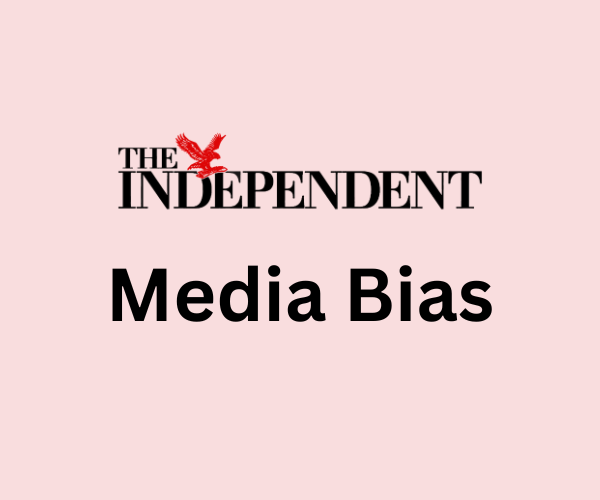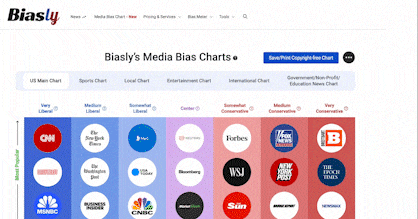
The Independent, founded in 1986, has established itself as a prominent newspaper in the United Kingdom, alongside other notable publications such as The Guardian. Throughout its history, The Independent has been recognized for its critical coverage of significant events, including the 2003 Iraq War, and has been associated with supporting progressive movements within Europe.
In this analysis, we will examine The Independent’s reporting and editorial decisions to assess whether a discernible political bias exists in their coverage. Our goal is to provide a comprehensive evaluation of The Independent’s journalistic practices and shed light on the factors that contribute to media bias. By exploring these aspects, we aim to offer a nuanced understanding of The Independent’s position in the media landscape and contribute to a broader discussion on the importance of objective reporting.
How Does Biasly Rate News Sources?
Biasly’s algorithms produce bias ratings to help provide multiple perspectives on given articles. Biasly has analyzed 200,000+ news articles from more than 3,200 news sources through our A.I. technology and team of political analysts to find the most factual, unbiased news stories.
Biasly determines the degree of political bias in news sources by using Biasly’s Bias Meter Rating, in which Biasly’s team analyzes media sources’ reliability and bias and produces three scores, a Reliability Score that measures the accuracy of media sources; an A.I. Bias Score, evaluated by A.I.; and an Analyst Bias Score evaluated by political analysts. These scores are rated based on seven rating metrics including Tone, Tendency, Diction, Author Check, Selection/Omission, Expediency Bias, and Accuracy. These metrics help our analysts to determine the political attitude of the article.
Our A.I. machine-learning system employs natural language processing and entity-specific sentiment analysis to examine individual articles and determine their bias levels. By analyzing the key terms in an article such as policies, bias phrases, political terminologies, politicians, and their nicknames, the algorithms can rate the attitude of the text. Bias scores range from -100% and 100%, with higher negative scores being more liberal and higher positive scores being more conservative, and 0% being neutral.
Is The Independent Politically Biased?
Biasly’s rating for the outlet is a media bias score of “Somewhat Liberal,” a score generated by its AI-based algorithms. Biasly’s AI bias analysis focuses on the leaning of tone, opinion, and diction of the author, and their respective tendencies. On issues related to abortion, clean energy, and BLM, the outlet “Somewhat Liberal.”
Biasly has assigned a “Somewhat Liberal” score as the Analyst Bias Score. Typically, alongside the Computer Bias Score, Biasly presents an Analyst Bias Score. This score is curated based on a review of at least 15 articles by a team of analysts representing liberal, moderate, and conservative viewpoints. Different types of bias in articles, preferences for liberal or conservative politicians and policies, all factor into generating these scores. The more articles the Biasly analyst team reviews and rates, the more precise the analyst score becomes.
In The Independent’s “Our Story” page on its website, it states that it is independent of any political parties. However, on this page, their record on how they reported international events leans left. For example, the outlet criticized the 2003 American and British invasion of Iraq, it says that it takes a progressive stance on European cooperation. However, regarding the British monarchy, they don’t take a Republican position.
For the July 2024 parliamentary elections, The Independent publicly endorsed the Labour Party. In doing so, the outlet has argued that the Conservative Party has been ripe with various scandals in the past few years. It includes “Partygate,” and the voters’ trust in the Conservative Party has been severely damaged.
Readers like you are more likely to have a strong opinion of The Independent based on your political leaning because of their tendency to favor liberal and left-wing causes, as represented by Biasly’s “Somewhat Liberal” rating. In the remainder of this article, we’ll talk about ways to identify this bias so you can separate the opinions from the facts and become a more informed consumer of news.
Before we begin, we need to discuss bias. Bias is a natural function of humans, and we can express it both consciously and unconsciously. Bias is one of the most fundamental forms of pattern recognition in humans. This isn’t to lower the bar and say that “all things are biased,” but to explain the process in which we may come to trust certain news organizations that display patterns of coverage.
On the media’s part, there is an incentive to retain audiences, encourage them to purchase subscriptions, and rate products positively. Bias is a two-way street, people want to see news stories about things they care about, and the media needs viewers to continue their operations. This creates a positive feedback loop that influences what stories are covered and from what perspective. This also explains the actions of more conservative or libertarian news organizations.
Analysis of Bias in The Independent’s Online Articles
When determining bias, some of the most common metrics used include Tone, Tendency, Author, Diction, and Expediency Bias, which are the primary metrics we’ll focus on below.
- Tone: This represents the attitude of the writing, formed distinctively but related to the author’s word choices or diction.
- Diction: The specific words chosen by the writer.
- Author: A metric related to the article’s author, taking into account their history of stance on issues based on past articles and social media posts. Tendency measures how consistently an author shows bias in their work, including factors like their tone and perspective.
- Expediency Bias relates to the immediate impression created by elements like the article’s headline, images, or summary, indicating if they favor a particular viewpoint.
Let’s examine this article, “What does fall of Assad in Syria mean for the Middle East and the West?” Biasly gave this article a bias rating of “Center,” and the overall policy sentiment was “Conservative.”

When looking at the expediency bias, the headline image that was used creates a jubilant atmosphere of the Syrian people raising the opposition flag after years of civil war and oppression. The viewpoint conveyed through the photo illustrates that they view Assad’s overthrow as a good thing.
However, when looking at the tone, it presented an analytical outlook of the topic. On the other hand, while it had a positive tone for Assad fleeing, it explained the possible challenges that could emerge with a new government. This is in line with more analytical articles found in outlets like Foreign Policy and Foreign Affairs, in which they present a nuanced analysis of an issue.
When examining the diction, the words used to describe Biden were slightly more positive than Trump. For example, in reacting to this situation, they mentioned Biden viewing it as a “historic opportunity” for the Syrian people. When analyzing Trump’s reaction, the article said:
“President-elect Donald Trump reiterated his longstanding opposition to US involvement in Syria. On social media, Trump dismissed Syria as “not our fight” and warned against further engagement.”
By using words like “dismissed,” it portrays Trump’s stance in a slightly negative light, even though his position is shared by many on the American right and American left.
When examining the author, Rachel Hagan is a freelance reporter who covers foreign affairs. Given her subject background, it would make sense that she authored this article. Based on her X account, she is generally supportive of pro-democracy movements and criticizes the killing of civilians. For example, even retweeted tweets that celebrated Assad’s departure, she also retweeted a post that criticized Israel’s war in Lebanon and was supportive of the women’s protests in Türkiye opposing female violence. So the bias that would have influenced the article was the reporter’s solidarity with pro-democracy movements in general, not the selective support for human rights that is common among Western politicians.
Let’s look at another article, titled “Kimberly Guilfoyle, Trump’s ambassador to Greece, once called Greeks ‘freeloaders.” The Biasly rating gave this article a “Somewhat Liberal” bias and its policy leaning was “Somewhat Liberal.”
When looking at the expediency bias, the image used was when Guilfoyle spoke at the RNC convention. Based on this image, it creates a perception that Guilfoyle is a tough person and as someone who is suitable to appear on a television show but does not convey her as being an individual capable of dealing with serious issues related to international diplomacy.
When examining the tone of the article, it generally has a negative attitude toward her nomination. It includes her prior remarks of calling the Greeks freeloaders, in reference to the Greeks accepting a bailout from the European Union. Moreover, the article portrayed Guilfoyle’s nomination being the result of having a close relationship with Donald Trump, especially his son Donald Trump Jr.
When examining the diction, the article references the words Guilfoyle used towards the Greek people, such as calling them ‘lazy’ and ‘freeloaders.’ The most emotive phrase Guilfoyle used to describe the Greeks was comparing them to untrained pets, by saying,
“nobody is punishing them” like when a “dog pees on the rug.”
When examining the author’s bias, Justin Baragona, he is a Senior Reporter for The Independent. Based on his X account, it is unknown as to what political positions he supports. On the one hand, he reposted a tweet that showed concern about the types of ads Donald Trump was propagating, such as there being a civil war in 2025.
Let’s check out what kind of ads are currently running on Trump’s Truth Social feed. pic.twitter.com/9d8nte39vK
— Justin Baragona (@justinbaragona) November 11, 2024
He also retweeted a tweet by Kaitlin Collins, a CNN reporter which said that Elise Stefanik called for the U.S. to leave the UN because of antisemitism.
News — Trump has offered Elise Stefanik the job as U.S. ambassador to the United Nations, a source familiar tells CNN.
— Kaitlan Collins (@kaitlancollins) November 11, 2024
However, it is unknown if Baragona reposted it because he agreed with it or reposted it merely to inform what Stefanik said. However, he was a former columnist for Zeteo, an independent news agency established by journalist Mehdi Hasan that has a reputation for critiquing American foreign policy and the right. In his columns for Zeteo, Baragona critiques the right-wing but also the mainstream media. Thus, his article on The Independent could have been influenced by his general worldview of critiquing a politician regardless of his/her political affiliation with a critical lens. His policy viewpoint appears to be more left-leaning based on these tweets.
Analysis of The Independent’s Opinion Articles
Before we answer this question, we need to draw the distinction between opinion and reporting. While reporting is intended to be neutral, giving the reader the facts and quotes from primary sources to let them form their own opinion, opinions are an outlet for columnists to express their personal views on the issues of the day. While we saw elements of factual reporting in the analysis above, The Independent opinion pieces don’t seek objectivity but prioritize putting forth an opinion instead.
One article, published in October 2014, criticized the media coverage of Africa. Titled, “Africa,” Ian Burnell wrote that the coverage of Africa should not be negative and insisted that the lives of Africans are like the British. While this article is not explicitly biased, it implicitly reflects a common left-leaning position that seeks positive coverage of the Global South and critiques Western bias.
However, another opinion article, published on November 9, 2024, titled “Britain needs to understand what an incomparable asset it has in the BBC World Service, argues its outgoing head,” portrays the positive aspect of the BBC. In this, the article touts the benefits of the BBC World Service and stresses that the UK media is facing immense competition from American, Chinese, Russian, and even Turkish media. This opinion article illustrates a more right-wing perspective.
These articles, in addition to those above, are only a small representation of all of The Independent’s content, but they indicate that the outlet is often characterized by a great deal of opinion — further underscoring the importance of knowing how to distinguish subjective writing from genuine reporting.
Who Owns The Independent?
For several years, The Independent was suffering from financial problems, due to a decline in readership. In 2016, the outlet ended its print edition entirely.
Later, there was much concern when Sultan Muhammad Abuljadayel, a Saudi investor bought 30% of the outlet in 2017. In response to this, the BBC published an article in 2017, called “Is The Independent Still Independent.” In this article, they referenced a quote from the outlet’s staff expressing their concerns about the future of editorial independence. The outlet’s remaining owners include Evgeny Lebdev owning 41%, Justin Byam Shaw owning 26%, and the remainder owned by minor shareholders.

Source: Wikipedia, Evgeny Lebdev, largest shareholder
Considering this, it is likely that they have positive coverage of Saudi Arabia. However, it is also essential to note that their criticism aimed at British or American policy in the Middle East should not be conflated with being owned by a Saudi individual.
How to Evaluate and Uncover Bias
It can often be difficult to tell if the news you watch is biased. If you have settled on a news channel, it’s usually because you trust the information you are gaining. Unfortunately, many trust the information they are hearing because it confirms what they already believe. This is referred to as “confirmation bias.” It is important to challenge your beliefs and get third-party verification that what you are hearing is the full story. This is why we recommend using Biasly to compare different news stories side-by-side using our bias ratings to figure out what both sides think of a political issue.
Even though Biasly gave The Independent a Somewhat Liberal bias score, remember that bias varies by article, and The Independent does not exclusively publish left-leaning pieces. In fact, it is known to have produced some right-wing and centrist articles before. Additionally, some article types will inherently have more or less bias; general news articles are known for being less biased than opinion pieces. And while every article you read will be biased to some degree, some stick to the facts better than others, which is why it’s so important to use Biasly’s News Check to help you determine the bias of what you read.























